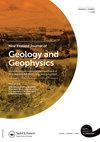Distributed displacement on the Papatea fault from the 2016 Mw 7.8 Kaikōura earthquake and implications for hazard planning
IF 1.9
4区 地球科学
Q1 GEOLOGY
New Zealand Journal of Geology and Geophysics
Pub Date : 2021-09-19
DOI:10.1080/00288306.2021.1975777
引用次数: 2
Abstract
ABSTRACT The distribution of ground motion, displacement, and secondary hazards around active faults is defined by the interaction of tectonic and site characteristics including fault kinematics. As a result of this complexity, recommendations for fault setback distances or avoidance zones are necessarily simplified. We observed distributed vertical coseismic displacement from the 2016 Mw 7.8 Kaikōura earthquake up to c. 500 m on either side of the sinistral-reverse Papatea fault. On average, c. 32% (2.13 m) of vertical displacement was measured at distances >50 m from the Papatea fault. Additionally, in places, there is strong asymmetry where displacement was accommodated over a wider area in the hanging wall of the fault, a common observation around many dip-slip fault ruptures globally. We compare the distribution of displacement around the Papatea fault to the current fault avoidance zone and find that increasing the size of the fault avoidance zone by 10 m captures 11% more area with a high gradient of vertical displacement. Given these results and similar findings for other faults globally, we recommend that existing standards for fault avoidance zones be evaluated to ensure their ongoing efficacy.2016年凯库拉7.8级地震Papatea断层的分布位移及其对灾害规划的影响
活动断层周围地面运动、位移和次生灾害的分布是由构造特征和场地特征(包括断层运动学)的相互作用来定义的。由于这种复杂性,必须简化故障后退距离或避免区的建议。我们观察到了从2016年凯库拉7.8级地震到约500级的垂直同震位移分布 m位于Papatea断层的左侧逆断层两侧。平均约32%(2.13 m) 垂直位移的测量距离>50 我来自木瓜断层。此外,在某些地方,断层上盘的位移范围更广,存在强烈的不对称性,这是全球许多倾滑断层破裂的常见观察结果。我们将木瓜断层周围的位移分布与当前的避断层带进行了比较,发现避断层带的大小增加了10 m捕获了11%以上的具有高垂直位移梯度的区域。鉴于这些结果以及全球其他断层的类似发现,我们建议对现有的断层回避区标准进行评估,以确保其持续有效。
本文章由计算机程序翻译,如有差异,请以英文原文为准。
求助全文
约1分钟内获得全文
求助全文
来源期刊
CiteScore
5.10
自引率
27.30%
发文量
34
审稿时长
>12 weeks
期刊介绍:
Aims: New Zealand is well respected for its growing research activity in the geosciences, particularly in circum-Pacific earth science. The New Zealand Journal of Geology and Geophysics plays an important role in disseminating field-based, experimental, and theoretical research to geoscientists with interests both within and beyond the circum-Pacific. Scope of submissions: The New Zealand Journal of Geology and Geophysics publishes original research papers, review papers, short communications and letters. We welcome submissions on all aspects of the earth sciences relevant to New Zealand, the Pacific Rim, and Antarctica. The subject matter includes geology, geophysics, physical geography and pedology.

 求助内容:
求助内容: 应助结果提醒方式:
应助结果提醒方式:


